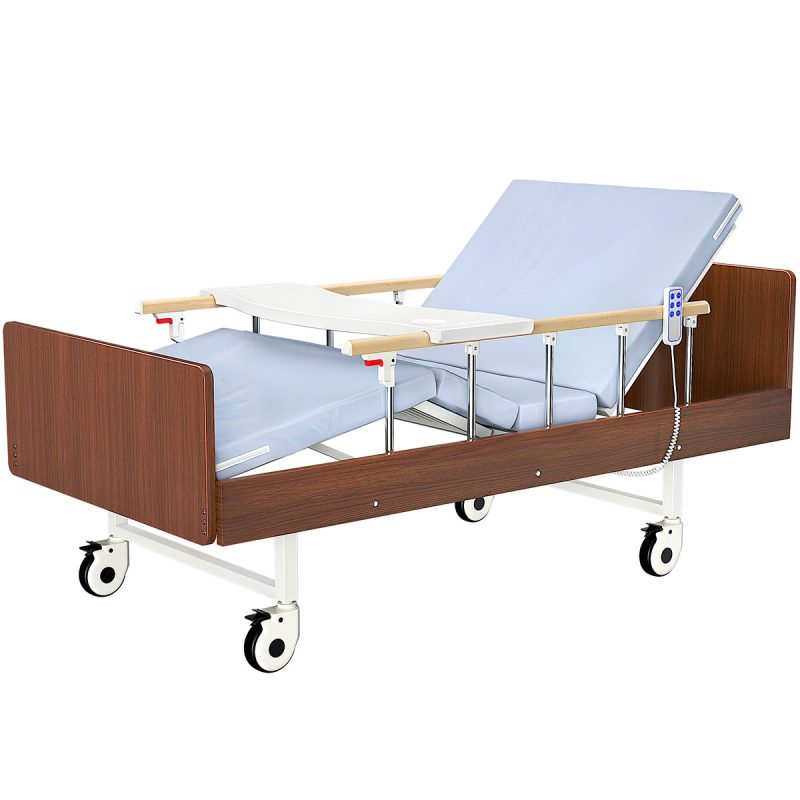The dimensions of a standard hospital bed are typically around 80 inches (203 cm) in length and 36 inches (91 cm) in width, with an adjustable height ranging from 15 inches (38 cm) to about 23 inches (58 cm) from the floor to the top of the mattress platform. These beds can also come with extenders to increase the length for taller patients. Bariatric hospital beds, designed for larger patients, can be wider, ranging from 42 inches (107 cm) to 48 inches (122 cm), and may also have higher weight capacities. The mattress dimensions should match the bed frame, usually 36 inches wide, 80 inches long, and around 6 inches (15 cm) thick. Adjustable features in hospital beds help facilitate patient transfers and improve comfort and safety for both patients and caregivers.

If you are considering purchasing a hospital bed, please visit the official website of https://www.epachois.com/, where the fully electric hospital beds are of high quality and extremely low prices.
Standard Dimensions of a Hospital Bed
Length
The standard length of a hospital bed is typically around 80 inches (203 cm). However, many hospital beds offer adjustable lengths or come with extenders that can increase the length to accommodate taller patients. Extended beds can range from 84 inches (213 cm) to even longer, ensuring patient comfort.
Width
The standard width of a hospital bed is approximately 36 inches (91 cm). Some beds, particularly those designed for bariatric patients, can be wider, ranging from 42 inches (107 cm) to 48 inches (122 cm). Wider beds provide additional space for larger patients and enhance comfort and safety.
Height
Hospital beds come with adjustable height features to facilitate patient transfers and care. The height of a hospital bed typically ranges from 15 inches (38 cm) to about 23 inches (58 cm) from the floor to the top of the mattress platform. This adjustability helps caregivers and patients find a comfortable and safe working height.
Mattress Dimensions
The mattress dimensions should match the bed frame to ensure proper fit and function. Standard hospital bed mattresses are usually 36 inches (91 cm) wide, 80 inches (203 cm) long, and about 6 inches (15 cm) thick. Bariatric mattresses are wider and sometimes longer to accommodate larger beds.
Related Questions
1. Are There Different Sizes of Hospital Beds?
Yes, hospital beds come in various sizes to meet different patient needs. Standard beds are 36 inches wide and 80 inches long, but larger options like bariatric beds are available. These beds can be wider and longer to support heavier patients and provide extra space for comfort.
2. Can the Dimensions of a Hospital Bed Be Adjusted?
Many hospital beds offer adjustable features, including length, width, and height. Bed extenders can increase the length, while some models allow width adjustments. The height can typically be adjusted to facilitate patient transfers and caregiver tasks, enhancing safety and comfort.
3. What Is the Weight Capacity of a Hospital Bed?
The weight capacity of a hospital bed varies depending on the model. Standard hospital beds usually support up to 450 pounds (204 kg). Bariatric beds are designed for heavier patients and can support weights up to 1,000 pounds (454 kg) or more. It’s essential to choose a bed that meets the patient’s weight requirements.
4. How Much Space Is Needed Around a Hospital Bed?
Adequate space around a hospital bed is essential for accessibility and safety. Generally, it’s recommended to have at least 3 feet (91 cm) of clearance on each side of the bed and at the foot of the bed. This space allows caregivers to perform their duties efficiently and ensures easy access for patient transfers and equipment.
In conclusion, understanding the dimensions of a hospital bed is crucial for selecting the right bed to meet patient needs and fit the available space. Standard hospital beds are typically 80 inches long, 36 inches wide, and have adjustable heights. Larger options, such as bariatric beds, provide additional space and support for heavier patients. By considering these dimensions and related factors, you can choose a hospital bed that ensures comfort, safety, and functionality.

